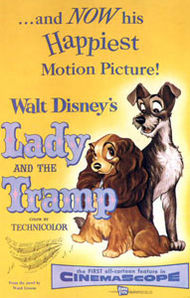I'll
be the first to admit that Lady and the
Tramp (1955) is not the most important or the most aesthetically creative
of Walt Disney's classic animated films, but it remains my favorite
nonetheless. It makes me laugh and cry every time I see it, and by now I have
seen it many, many times. What more can you ask for in a classic film? Beautifully
drawn, movingly sincere, and oddly enough more human than many of the films
featuring human characters, Lady and the
Tramp is the Disney movie for dog lovers and hopeless romantics alike.
The
story follows the early life and growth of Lady, a pampered Cocker Spaniel in
an elegant Victorian home. Lady gets a shock when she discovers that her
owners' feelings about her have changed because they are expecting a baby, and
she gets an even bigger shock when mean Aunt Sarah is called in to care for the
baby while Jim Dear and Darling leave town for a few days. The canine heroine
eventually finds herself tangled up with a rakish stray called The Tramp, but
his attentions only manage to land her in trouble, first in the dog pound and
then in the dog house back at home. Of course, being a Disney film, a happy
ending is guaranteed, with the budding romance of Lady and the Tramp evoked
most memorably in the spaghetti eating scene.
Barbara
Luddy provided the voice of Lady, and it was a perfect part for the Disney
regular, who would go on to be the voice of the fairy Merryweather in Sleeping Beauty (1959) and of Kanga in
numerous Winnie the Pooh films. In Lady and the Tramp, Luddy's voice has a
soft sweetness undercut with just enough rasp to make her feisty as well as
feminine. The voice that dominates the film, though, is that of the incomparable
Peggy Lee, the chanteuse best known today, perhaps, for the hit song
"Fever." Lee lent her voice to four different characters in the film,
Darling, Siamese cats Si and Am, and Peg, and she also helped write several of
the songs featured in the picture. We hear Lee singing numerous times during
the film, but the highlight is certainly her rendition of "He's a
Tramp," sung by Peg, the bedraggled Pekingese at the dog pound. Lee had
some legal quarrels with Disney over her work on the movie, but, in the long
run, it has served her well, introducing her to generations of youngsters who otherwise
would never have heard her gorgeous sound.
The
danger in which the movie can place its characters is one of the reasons that Lady and the Tramp has such pathos;
imagine one of the Disney princesses being thrown into prison and made to watch
another prisoner dragged away to his death. The pound scene is one of the film's
most moving moments; certainly the animals are humanized to a certain extent,
but their misery is very real, as anyone who has walked the kennels of an
animal shelter can attest. Lady's fear and confusion are emotions any pet might
feel at suddenly being dumped in such an unfamiliar place. Lady spends almost
the entire movie being bound, caged, threatened, muzzled, and shot at, and
Tramp is literally being carted away to his execution when Jock and Trusty rush
to the rescue. Trusty's encounter with the dog pound carriage, and Jock's
reaction, can still bring tears to the eyes of viewers who have watched the
movie dozens of times and know perfectly well how it ends. (Walt insisted that
Trusty had to survive the crash because he remembered the emotional fallout
from killing Bambi's mother.)
There's
also the romantic angle of the movie to consider. For young girls, Tramp might
well be their first encounter with the figure of the charming rogue, that
lovable scruffy guy who isn't exactly a knight in shining armor but who manages
to win the day and the girl anyway. Disney would revisit this territory to
great effect in its treatment of Robin
Hood (1973). Tramp is, quite literally, the Han Solo of the canine world;
he lacks the pedigree of a prince, but he makes up for it in dash and swagger
and the thrill of going out with the bad boy instead of the football team
captain. As a dog, Tramp can get away with being a lot more dangerous an object
of affection. Parents in 1955 would have had a heart attack had this romance
played out between a human debutante and a rogue from the wrong side of the
tracks, and not until Aladdin in 1992
would Disney try out this kind of love story with people instead of animals.
Even more daring is the fact that Lady spends the night with Tramp out on
Lovers Lane; I doubt Disney would try that scene with human characters even in
this enlightened age.
I
have never been a big fan of the classic princess films, largely because their
heroines are all too insipid and ineffectual for my tastes, but Lady and the Tramp can be more egalitarian
because it features dogs instead of people, and that is part of its charm. Lady
might be all that her name implies, but she still gets to chase chickens, bark
at rats, and exercise her animal spirits. She gets to run around town with a
tough, sexy guy, too. It might be a dog's life, but I'll take that over being a
narcoleptic princess any day.
An earlier version of this review originally appeared on Examiner.com. The author retains all rights to this content.

No comments:
Post a Comment